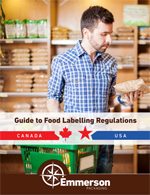Food Labeling Changes Are Better For Consumers
March 2, 2017
With just 16 months to go before the first food labeling change deadline, food manufacturers may be feeling the pressure—but many consumers are looking forward to the food labeling changes.
A healthy, balanced diet is a key element of maintaining good health, so clearer food labeling that makes it easier to determine exactly what you’re consuming is a benefit to increasingly health-conscious shoppers. Additionally, clearer allergen labeling will make food shopping easier for the millions of North American adults who suffer from food allergies.
Food Labeling Changes in the USA: The Benefits
The original NLEA (Nutrition Labeling and Education Act) guidelines were introduced by the FDA in 1990 and took effect in 1994. These guidelines were intended to help the public better understand what they were consuming and avoid over-consumption (and under-consumption) of certain nutrients.
Since that time, the average serving size has changed, and new scientific information has established a link between diet and chronic diseases such as heart disease and obesity. Additionally, the rise in popularity of convenience packaging—including single-serve and packages meant to be used for on-the-go consumption—has necessitated a more cohesive set of rules around displaying realistic serving sizes on food labels. For example, if 100g of a given food is sold in a single-serving size package but the label shows nutritional facts for an 80g serving, the average consumer may find it difficult to determine exactly what they are eating.
And while Vitamin A and Vitamin C deficiencies are now relatively rare, NutritionFacts.org claims that 98% of Americans do not get enough potassium in their diets[1], and the importance of adequate Vitamin D intake has been proven by recent research (more information from the U.S. National Institute of Health can be found here). Once the food labeling changes take effect, listing Vitamin A & C content on the NFT will become voluntarily, but potassium and Vitamin D content will be mandatory.
Finally, the Nutrition Facts Table will be required to clearly state a food’s total added sugars. As the FDA stated in their May 2016 release: “The scientific evidence underlying the 2010 and the 2015-2020 Dietary Guidelines for Americans support reducing caloric intake from added sugars; and expert groups such as the American Heart Association, the American Academy of Pediatrics, the Institute of Medicine and the World Health Organization also recommend decreasing intake of added sugars.”[2]
Food Labeling Changes in Canada: The Benefits
Many of Health Canada’s recently announced food labeling changes mirror those being made in the USA. Serving sizes are being updated to reflect realistic portions and to be more consistent with similar types of foods, making comparisons between two different foods easier for the average consumer. As in the USA, total calories will now be printed in a larger font for easier identification, and potassium content will be required information.
In addition, Health Canada is making changes to ingredients list requirements to help Canadians make better-informed choices about total sugar consumption, and make it easier to avoid food allergens. When the new regulations take effect in 2021, producers will be required to group together all sources of sugar in an ingredients list, and then list them individually within brackets. This helps give Canadian consumers a clearer picture of how much sugar they are really consuming in any given food.
Food allergens on Canadian packaging are subject to new rules, too. They must be listed in a visually similar way to the main ingredients list, using clear language, within the same label element as the ingredients list. The type of allergen (e.g. “Tree nut”) must be printed along with the name of the specific allergen (e.g. “Cashew”).
Need Help With Food Labeling Changes?
There are a lot of food labeling changes coming to both sides of the border—many more than we’ve covered in this post.
With the FDA deadline looming and Health Canada deadlines not far behind, it’s time to take action and prepare for compliance with new food labeling regulations. To get started, download our FREE Guide to Food Labeling Regulations: USA vs. Canada and learn what the latest requirements are in each country—as well as how they compare to each other—in clear language and an easy-to-read format.

Then, contact our Project Central department to learn how Emmerson Packaging can remove the headache that comes with making sure your packaging is FDA and Health Canada compliant—on time and on budget.
[1] Greger, Michael (M.D., FALCM) “98% of American Diets Potassium-Deficient”



